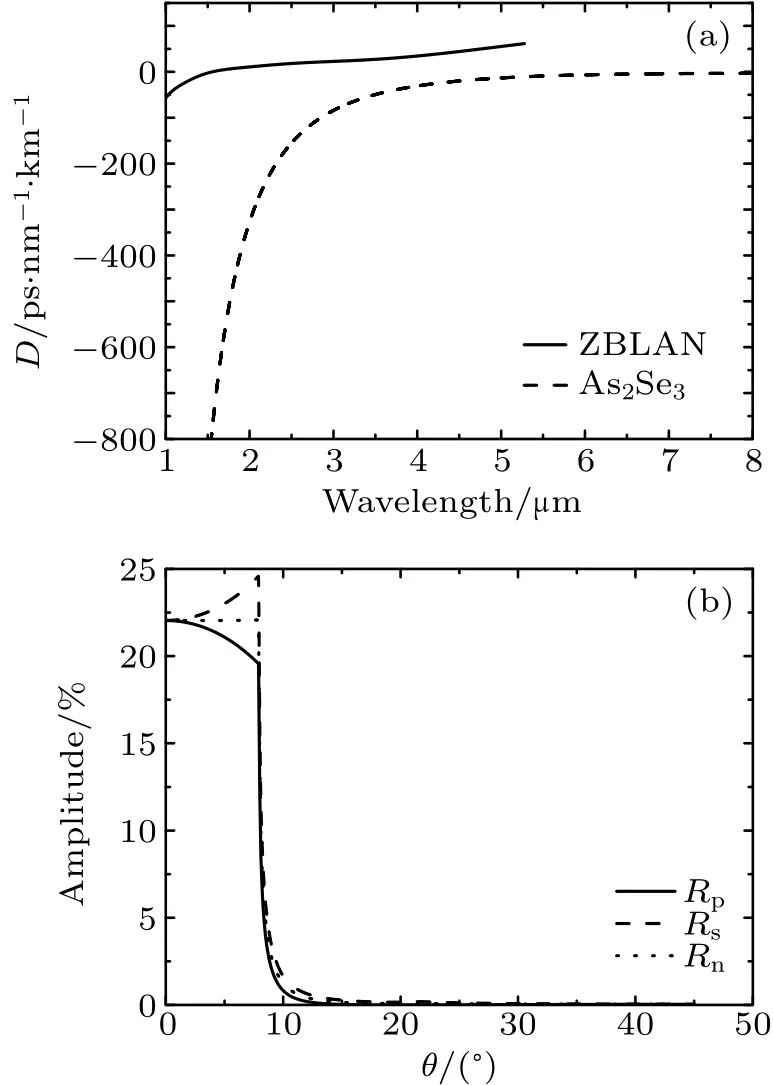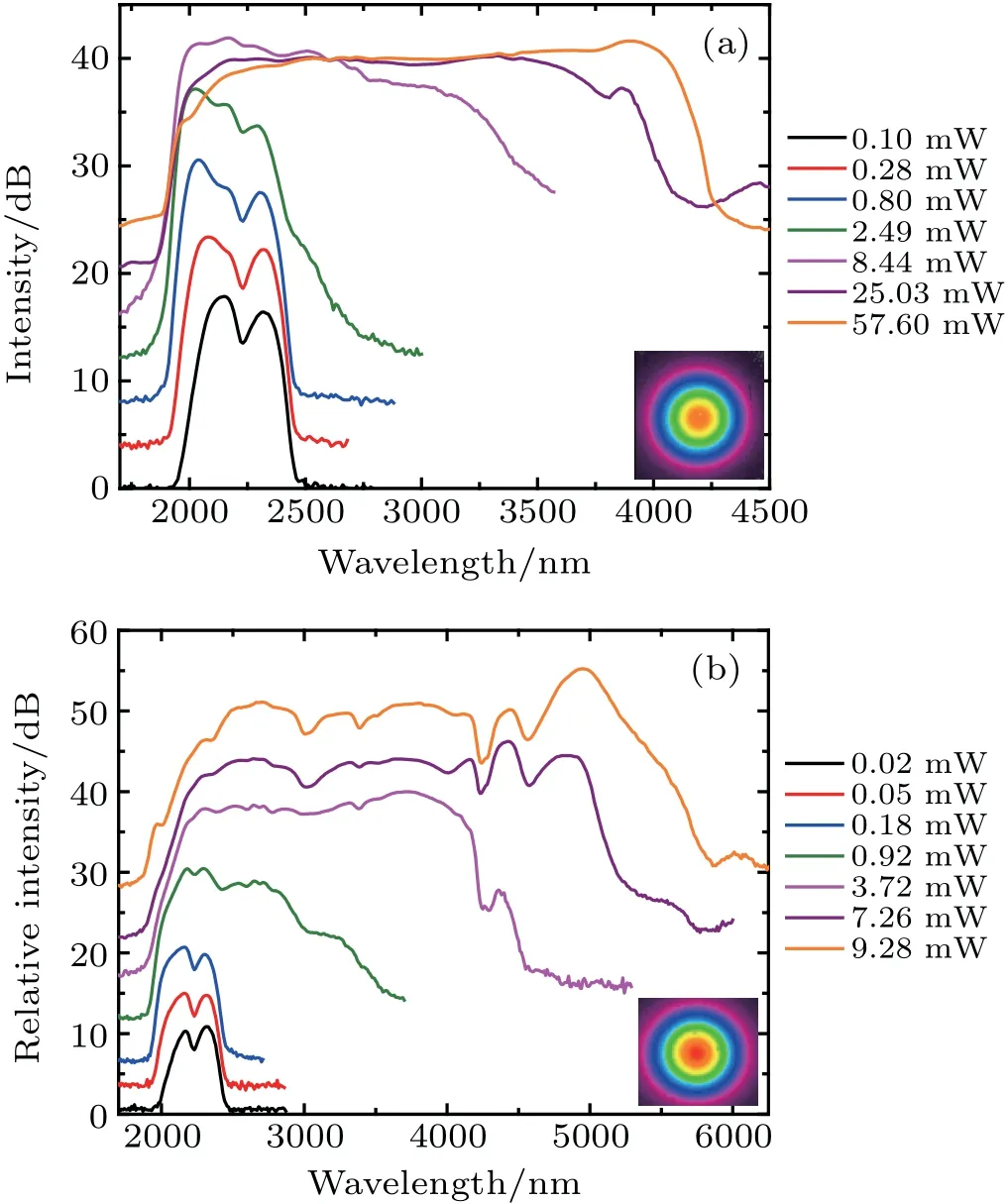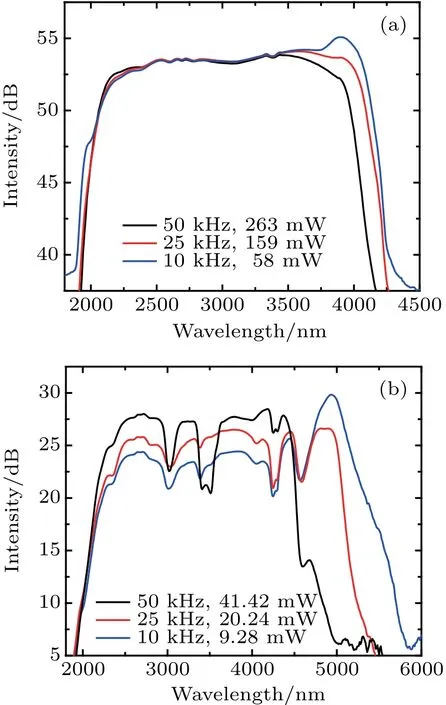The 2-μm to 6-μm mid-infrared supercontinuum generation in cascaded ZBLAN and As2Se3 step-index fibers?
Jinmei Yao(姚金妹), Bin Zhang(張斌),2,3,?, Ke Yin(殷科), and Jing Hou(侯靜),2,3,?
1Colle ge of Advanced Interdisciplinary Studies,National University of Defense Technology,Changsha 410073,China
2State Key Laboratory of Pulsed Power Laser Technology,Changsha 410073,China
3Hunan Provincial Key Laboratory of High Energy Laser Technology,Changsha 410073,China
4National Innovation Institute of Defense Technology,Academy of Military Sciences PLA,Beijing 100010,China
Keywords: supercontinuum generation,infrared lasers,fiber lasers,nonlinear
1. Introduction
The fiber-based supercontinuum (SC) sources offer both a broad bandwidth and a good beam quality. Particularly,SC sources in the mid-infrared (MIR) region attract enormous interest due to its potential applications in many fields,such as spectroscopic imaging,[1]trace gas detection,[2]and early-cancer diagnosis.[3]Consequently, there have been a growing number of experiments aiming at generating MIR SC using a wide variety of nonlinear fibers. Traditionally,hindered by infrared absorption of silica glass, the longwavelength edge of SC generated in silica fibers is limited at~2.7 μm.[4]Germania-core fibers have a lower phonon energy compared with silica fibers, which could further extend the long-wavelength edge of SC to about 3.6 μm.[5]For further broadening the SC spectrum, soft-glass fibers, such as fluoride fibers, tellurite fibers, and chalcogenide fibers, are much more suitable. The most common fluoride glasses are fluorozirconate glass ZrF4-BaF2-LaF3-AlF3-NaF (ZBLAN)and fluoroindate glass (InF3). The ZBLAN glass is a mixture of ZrF4(53 mol.%), BaF2(20 mol.%), LaF3(4 mol.%),AlF3(3 mol.%), and NaF (20 mol.%).[6]To date, >10 W MIR SCs have been reported in ZBLAN glass fibers,[7-9]but the long-wavelength edge is limited at around 4.2 μm due to multiphonon absorption edge when using long fibers.The InF3glasses own lower phonon energy compared with ZBLAN glasses,thus the long-wavelength edge of SC generated in InF3fibers has been extended up to 5μm with the output power reaching watt level.[10-12]To further boost output power and increase long term stability of fluorite fiber-based SC sources, protective methods like an AlF3endcap[13]need to be applied for preventing OH diffusion. Tellurite-based(TeO2)glasses yield a higher resistance to moisture exposure than fluorides glass and it has a similar transmission band with fluorozirconate glass.[6]A watt-level MIR SC source covering 1 μm to 4.5 μm is obtained in a dispersion-zero shifted tellurite fiber with an output power of 1.2 W.[14]Recently, to improve the stability of fluoride glass fiber,a kind of fluorotellurite glass (TeO2-BaF2-Y2O3) fiber with improved chemical and thermal properties has been reported.[15]Pumped by a homemade 1980-nm chirped pulse amplification, a 10.4-W SC spanning from 947 nm to 3934 nm was obtained without obvious damage observed on the end surface of the fluorotellurite fiber for more than 10 h. Chalcogenide fibers are a kind of MIR fiber,which is based on the chalcogen elements S,Se,and Te with transmission windows of 0.8 μm-7 μm, 1 μm-10μm,and 2μm-12μm,respectively. These fibers naturally yield a wide transmission window in the MIR region and a stable chemical property.[16-19]
Chalcogenide fibers usually have high zero-dispersion wavelengths (ZDWs)[16]which are far away from general fiber laser. Due to the lack of mature and reliable MIR fiber lasers, free-space pump lasers like optical parametric am-plifiers with ultra-short MIR pulses are widely employed in the chalcogenide fiber-based SC systems[20-25]and great progresses have been achieved using this method. The broadest MIR SC generated in a nonlinear fiber is achieved in a piece of low-loss chalcogenide fiber,which covers 2.0μm-16.0μm at the-40-dB level.[20]Practical applications require portable and stable SC sources which can work beyond the laboratory environment. Thus,the fiber laser with robust construction is the ideal pump source for SC generation. Cascaded SC generation in the chalcogenide fiber was proposed in 2014[26]and realized in 2016.[27]In this method,MIR soliton pulses generated in the ZBLAN fiber can further broaden toward the longwavelength region in the chalcogenide fiber. This method can meet the need of MIR pump pulse for chalcogenide fibers and it naturally has the potential to develop an all-fiber MIR SC system. Adopting this method, an all-fiber SC laser covering 2μm to 5μm was obtained in an As2S3step index fiber with an output power of 97.1 mW.[28]And an MIR SC up to 7μm was obtained in a micro-structured As2Se3fiber with an output power of about 6.5 mW.[27]
In this paper, an SC spanning from 2 μm to 6 μm is demonstrated in cascaded ZBLAN and As2Se3step-index fibers.The ZBLAN fiber is used to build an MIR SC laser with abundant high-peak-power soliton pulses between 3000 nm and 4200 nm. By coupling solitons generated in ZBLAN fiber into the following step-index As2Se3fiber, MIR pulses further broaden toward long-wavelength region in the normal dispersion region of As2Se3fiber. The spectral behavior of the cascaded SC generation is investigated by changing the pump power and pump repetition rate, which shows that the long-wavelength power generated in the ZBLAN fiber plays a critical role for further spectral broadening in the As2Se3fiber.
2. Experimental setup
The experimental setup for SC generation is shown in Fig. 1(a). The 1550-nm seed with 1-ns pulse duration and 10-kHz repetition rate is amplified in an erbium/ytterbiumcodoped fiber amplifier (EYDFA) first and then injected into a 15-m-long single-mode fiber (SMF). An effective spectral broadening covering 1.5 μm to 2.3 μm is obtained during propagating in the SMF. Then spectral components from 1.5μm to 1.9μm are absorbed in a large-mode-area thuliumdoped fiber (LMA-TDF) with a core/cladding diameter of 25 μm/250 μm and numerical aperture (NA) of 0.11/0.46,while the spectral components above 1.9 μm are amplified.Two mode field adapters(MFAs)are adopted in the thuliumdoped fiber amplifier(TDFA)stage. The pigtail of the MFA2 has a core/cladding diameter of 7μm/125μm and a core NA of 0.2. The amplified pulses generated in LMA-TDF are sequentially shifted towards long wavelength region in the MFA and eventually lead to a 1.9μm-2.7μm SC laser.

Fig.1. (a)Experimental set-up for SC generation in cascaded ZBLAN and As2Se3 step-index fibers. LMA-TDF:Large mode area thulium-doped fiber;SM:Single-mode;MFA:mode field adapter. (b)Microscope and(c)photograph of fusion splicing between silica fiber and ZBLAN fiber.
To effectively broaden the MIR spectrum, a 12-m-long ZBLAN fiber with a core/cladding diameter of 9/125μm and an NA of 0.27 is used. Low-loss fusion splice is achieved between the ZBLAN fiber and the pigtail of MFA2 by asymmetric heating method.[29]Figures 1(b) and 1(c) depict the microscope and photograph of fusion splicing between silica fiber and ZBLAN fiber,respectively.This shows that the silica fiber is wrapped by the melted ZBLAN fiber, which forms a robust fusion splicing between silica fiber and ZBLAN fiber.For protecting the fusion-spliced joint,it was mounted into an aluminum V-groove and fixed with ultraviolet curing adhesive,as shown in the inset of Fig.1(a). The fusion splicing loss is estimated to be less than 0.1 dB after considering the linear propagation loss at around 2 μm (0.06 dB/m) and the mode mismatch loss between the pigtail of MFA2 and the ZBLAN fiber of about 0.024 dB. Based on the commercial finite element method software COMSOL Multiphysics and Sellmeier equation with the same coefficients as in Ref.[30],the calculated group velocity dispersion of the ZBLAN fiber is depicted in Fig.2(a),which shows that it exhibits anomalous dispersion from around 1.5 μm to its multiphonon absorption edge near 4.3μm.
To effectively confine MIR wavelengths in the core of As2Se3fiber and achieve a sufficient nonlinear interaction length, a 5-m-long As2Se3fiber with large core diameter of 12μm and NA of 0.46 is used. Based on the Sellmeier equation with the same coefficients as in Ref. [31], the ZDW of the As2Se3fiber is calculated at above 8 μm, as shown in Fig.2(a). Selenium glass fibers own high refractive indices in the MIR region(n=2.77 at 4μm),thus there is about 22%optical feedback resulting from Fresnel reflection at the end facet of As2Se3fiber. Angle-cleaved As2Se3fiber end can prevent backward propagated light to some extent. Figure 2(b)depicts the relationship between the cutting angle of the As2Se3fiber and the proportion of optical feedback that meets the total reflection condition in the core of the As2Se3fiber. Due to the large NA of the As2Se3fiber,a large cutting angle is required at the end facet of As2Se3fiber.A cutting angle of about 12°is obtained in the experiment,which means that about 0.4%SC feedback propagates backwards in the core of As2Se3fiber.The As2Se3fiber is placed on an aluminum plate without applying any active cooling method. Both end facets of As2Se3fiber are placed in a pair of parallel V-grooves and indiumgallium alloy is applied to strip possible cladding light.

Fig. 2. (a) Calculated group velocity dispersions of the ZBLAN fiber and As2Se3 fiber. (b) The relationship between the cutting angle of the As2Se3 fiber and Fresnel reflection proportion that meets the total reflection condition in the core of the As2Se3 fiber. Rp,Rs,and Rn represents reflection of P-light,S-light,and total light,respectively.
To flexibly control the light spot incident into the As2Se3fiber, a pair of Ge28Sb12Se60aspheric lenses with antireflection coating covering 3 μm-5 μm is adopted to achieve light coupling between the ZBLAN fiber and the As2Se3fiber. The focal lengths of the lenses are 6 mm and 4 mm,respectively.A monochromator with liquid-nitrogen-cooled InSb detector and a thermal power meter are used for the measurement of spectrum and power, respectively. With the aid of a pyro-electric array camera, fundamental mode operation is ensured during the coupling alignment.
3. Results and discussion
The measured spectral evolution in the ZBLAN fiber pumped at 10-kHz repetition rate is depicted in Fig. 3(a) and the legend represents the corresponding output power. As TDFA pump power increases, the spectra of short subpulses generated in the LMA-TDF further broaden in the anomalous dispersion region of ZBLAN fiber and gradually reach~4.3 μm. Abundant high-peak-power soliton pulses located between 3000 nm and 4200 nm are the dominant components of SC generated in ZBLAN fiber. Then, the output MIR SC generated in the ZBLAN fiber is coupled into the following As2Se3fiber with the pair of aspheric lenses. Due to the antireflection coating covering 3 μm-5 μm, the coupling efficiency is only ~50% before the pump spectrum reaches beyond 3μm.With the pump spectrum generated in the ZBLAN fiber reaching 4.2 μm, the coupling efficiency gradually increases to about 80%.
The spectral evolution in the following As2Se3fiber is depicted in Fig. 3(b) and the legend represents output power corresponding to the pump power in Fig. 3(a). For a clear visibility, each spectrum is shifted upward by 4 dB. This shows that at the beginning, the output solitons generated in the ZBLAN fiber are too weak to induce continue SC extension in As2Se3fiber. Until the output power of ZBLAN fiber is about 2.49 mW, a significant spectral broadening is observed in the As2Se3fiber. As the pump power is further increased, a cascaded spectral broadening of ~1000 nm is achieved in the As2Se3fiber and finally an MIR SC spanning from 2 μm-6 μm is obtained with corresponding -10-dBm points from 2.2 μm to 5.5 μm. Self-phase modulation and Raman-induced frequency red-shift in the normal dispersion regime of the As2Se3fiber are regarded as the dominant mechanisms responsible for cascaded spectral broadening. Obvious Stokes peaks are hard to be distinguished in the output spectra of As2Se3fiber due to pump soliton pulses with different center wavelengths.Two spectral dips beyond 4μm can be observed in the output spectrum of As2Se3fiber.The spectral dip at 4.2 μm is caused by the CO2absorption during free space propagation of spectral measurement. The Se-H bond in the fiber causes the dip at around 4.6μm.Near-field beam profiles detected at the output end of ZBLAN fiber and As2Se3fiber are shown in the inset of Fig. 3. Although the single-mode cutoff wavelength of As2Se3fiber is calculated as 7.4μm,the fundamental mode can be excited by proper alignment.

Fig. 3. Measured spectral evolution of SC generated in the (a) 12-mlong ZBLAN fiber and (b) 5-m-long As2Se3 fiber pumped at 10-kHz repetition rate. The legend represents output power and the insets show the corresponded SC beam profiles.
The spectral behaviors of MIR SC are investigated by changing the pump repetition rate.Figures 4(a)and 4(b)depict the comparison of SC spectra generated in ZBLAN fiber and As2Se3fiber pumped at 10 kHz,25 kHz,and 50 kHz,respectively. It shows that although 2μm-4.2μm SCs are obtained in the ZBLAN fiber at all pump repetition rates, the broadest cascading SC is generated in the As2Se3fiber when pumped at 10 kHz. A possible explanation for this comes from the fact that solitons cannot propagate undistorted in the normal dispersion region of the As2Se3fiber for a long distance. When solitons are incident into the As2Se3fiber, self-phase modulation along with Raman-induced frequency red-shift leads to spectral broadening of SC. Meanwhile, time domain broadening of solitons occurs due to group dispersion. Along with the decrease of temporal intensity of pump pulse, self-phase modulation and Raman-induced frequency red-shift gradually stop in the As2Se3fiber. Consequently, long-wavelength solitons with low group velocity dispersions indices in the As2Se3fiber are beneficial for continuing SC broadening.Since most intense MIR solitons are obtained in the ZBLAN fiber at a repetition rate of 10 kHz, the broadest SC is generated in the As2Se3fiber at 10 kHz. For effective obtaining MIR SC extension in As2Se3fiber, the energy of long wavelength solitons generated in ZBLAN fiber needs to be boosted.For example, InF3 fibers with lower phonon energy in MIR region can be used to replace the ZBLAN fiber in the cascading configuration.[32]Or a piece of As2S3fiber can be added as an intermediate fiber between the ZBLAN fiber and the As2Se3fiber for further bridging the matching-gap between the pump wavelength and ZDW of the As2Se3fiber, which contributes to a 1.6 μm-11 μm SC laser source in a recent report.[33]

Fig.4.Comparison of the SC spectra generated in(a)ZBLAN fiber and(b)As2Se3 fiber pumped at 10 kHz,25 kHz,and 50 kHz,respectively.The legend represents the output power of the ZBLAN fiber and As2Se3 fiber,respectively.

Fig.5. (a)Damaged vertical incident facet of As2Se3 fiber pumped at 50-kHz repetition rate with maximum pump power of 263 mW;(b)optical microscope image of the longitudinal input segment of damaged As2Se3 fiber.
Further SC extension is prohibited in As2Se3fiber at a repetition rate of 50-kHz through raising the pump power.When the pump power is increased above 263 mW, the output power of As2Se3fiber suddenly decreases unexpectedly.The optical microscope image of the incident facet of As2Se3fiber shows that there is a distinct cavity like a ‘crater’ with a similar dimension as the core diameter of As2Se3fiber, as shown in Fig.5(a). Figure 5(b)depicts the optical microscope image of longitudinal input segment of the As2Se3fiber. A~200-μm-long deformation and an intra-core hollow are detected in the As2Se3fiber,which indicates that an eruption of the core of As2Se3fiber has occurred. According to Ref.[34],a core material blast from the input facet is one of the distinct features of fiber fuse,in contrast with other fiber damage mechanisms. It is inferred that fiber fuse has occurred in the As2Se3fiber.4. Conclusion
In this paper, an MIR SC spanning from 2 μm to 6 μm is achieved in cascaded ZBLAN and As2Se3step-index fibers with an output power of 9.28 mW. The spectral behaviors of the SC source are investigated by changing the pump repetition rate and the pump power, which shows that the longwavelength power generated in ZBLAN fiber plays a critical role for further spectral broadening in As2Se3fiber. A damaged cross section is observed on the incident end facet of As2Se3fiber while increasing the laser repetition rate, which suggests that in order to acquire a high-power MIR SC, improved fabrication of chalcogenide fiber along with a better understanding of the damage mechanism is needed.
- Chinese Physics B的其它文章
- Lorentz transmission electron microscopy for magnetic skyrmions imaging?
- Spin transport in antiferromagnetic insulators?
- First-principles study of the band gap tuning and doping control in CdSexTe1-x alloy for high efficiency solar cell?
- Non-Stokes drag coefficient in single-particle electrophoresis:New insights on a classical problem
- SymTopo: An automatic tool for calculating topological properties of nonmagnetic crystalline materials?
- Tunable coupling between Xmon qubit and coplanar waveguide resonator?

